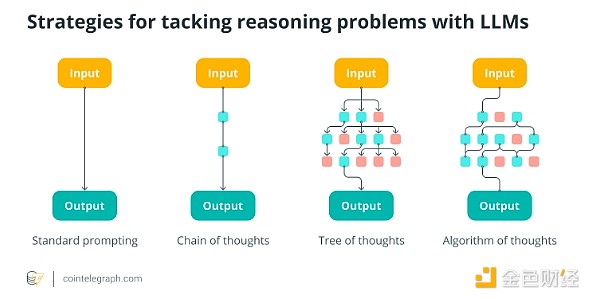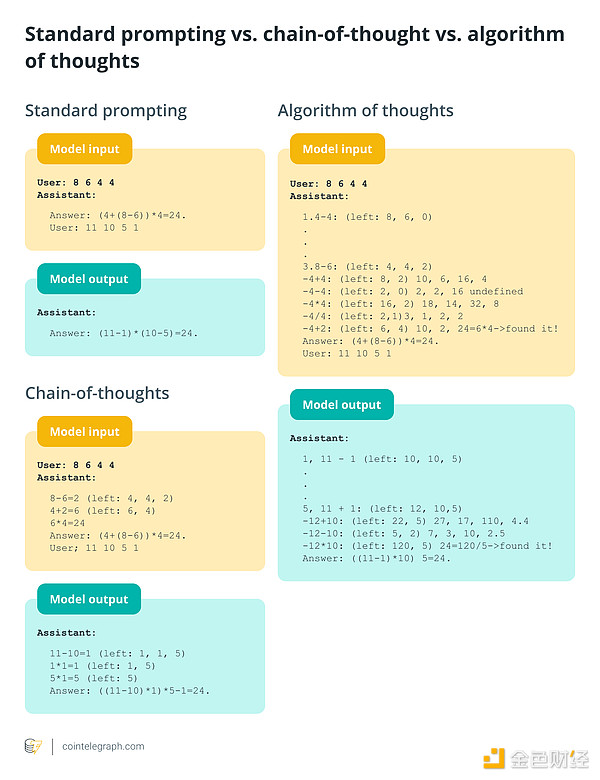Author: Aimen Noor, CoinTelegraph; Compiler: Wuzhu, Golden Finance
1. Explanation of Algorithm of Thought (AoT)
AoT enhances AI reasoning capabilities by imitating human thought processes, improving adaptability and efficiency in problem solving.
Algorithm of Thought (AoT) is a breakthrough approach in the field of artificial intelligence (AI) that revolutionizes the way AI models think and reason. Developed by Microsoft Research, AoT introduces a new paradigm for large language models (LLMs) to enhance reasoning capabilities to solve complex problems. It aims to combine the best of both worlds: a nuanced and intuitive understanding of the human thought process with a structured and systematic algorithmic approach.
AoT differs from previous approaches that relied on external intervention to guide LLMs through reasoning steps. Instead, it leverages the inherent ability of LLMs to explore problem spaces by imitating human thought patterns. This enables LLMs to dynamically adjust their approaches based on context, making them more adaptive and efficient.

The above figure shows different strategies for solving reasoning problems using LLM. It shows the progression from basic prompts to more complex methods such as thought chains, thought trees, and thought algorithms. Each box represents an idea, green for promising ideas and red for less promising ideas, leading the LLM to find a solution.
The strategies are explained below:
Basic prompts: Ask the LLM a question directly or give it a task.
Chain of Thoughts (CoT): The LLM generates a series of intermediate reasoning steps before arriving at the final answer, just like explaining its thought process.
Tree of Thoughts (ToT):LLM explores multiple reasoning paths simultaneously, evaluates each and selects the most promising one to continue, just like brainstorming different approaches.
Algorithm of Thoughts (AoT):Combining CoT and ToT, an algorithm is used to systematically search and evaluate different reasoning paths, like a more structured and efficient way to find solutions.
Essentially, AoT enables AI models to navigate a vast universe of possibilities, similar to how humans brainstorm and refine ideas to arrive at solutions. This approach has shown great potential in improving the performance of LLMs on a variety of reasoning tasks, outperforming previous methods in terms of accuracy, efficiency, and flexibility.
II. How does AoT outperform existing methods?
AoT revolutionizes AI by making reasoning transparent, efficient, and adaptable, outperforming traditional models in problem solving and decision making.
AoT is a revolutionary approach in the field of AI that fundamentally changes the way humans understand and utilize LLMs. Its advantage over traditional models is most evident in its transformed reasoning process. AoT makes this process transparent, providing a step-by-step breakdown of the model's ideas, unlike the opaque "black box" nature of previous LLMs.
In addition to transparency, AoT also significantly improves the efficiency of LLMs. But how does AoT mimic human thinking in AI models? It does this by dynamically adjusting the reasoning process based on context, allowing the model to explore multiple paths and prune those that are less promising. This dynamic, human-like approach contrasts with the linear and often inefficient way traditional models solve problems. AoT allows models to adapt to complex tasks and find solutions faster and more accurately.

In addition, AoT-enhanced models show extraordinary adaptability due to their ability to learn in context. Traditional LLMs usually have difficulty processing new information and need to be retrained to handle new tasks. However, AoT models can generalize their knowledge and adapt to new information presented in the prompt itself, making them more general and practical in real-world scenarios.
III. Practical Applications of AoT
AoT has the potential to revolutionize various fields, including scientific research, software development, supply chain optimization, financial forecasting, etc.
In scientific research, AoT can accelerate the discovery of new drugs and new therapies by assisting in analyzing complex biological data and identifying potential therapeutic targets.
In software development, AoT can revolutionize the way code is written and debugged. By providing developers with an AI assistant that can reason about complex code structures, identify potential errors, and propose optimal solutions, AoT can improve productivity and code quality. It can also help automate repetitive tasks, allowing developers to focus on more creative and strategic aspects of their work.
Beyond these specific applications, the potential of AoT extends to other industries and fields. From optimizing supply chains and logistics to improving financial forecasting and risk assessment, AoT's ability to analyze large amounts of data and generate insights can drive efficiency, innovation, and decision-making across the board.
Four Challenges and Limitations of AoT
Despite its great potential, AoT also faces many challenges, such as increased computational costs, sensitivity to input quality, subjective evaluation, and ethical concerns about potential abuse.
Despite its powerful capabilities, AoT also has challenges and limitations. One of the main issues is that computational costs can increase due to exploring multiple reasoning paths.
In addition, AoT’s reliance on contextual learning and chain of thought prompts can be sensitive to the quality and relevance of the examples provided, which can affect its overall performance if the examples are poorly chosen or insufficient.
In addition, due to the inherent subjectivity of human-like reasoning, the evaluation of AoT’s performance can be tricky. Comparing its output to human reasoning may not always yield a clear answer, as there may be multiple valid ways to solve a problem.
This makes it difficult to establish standardized metrics to evaluate the effectiveness of AoT in different domains and tasks. In addition, ensuring the ethical use of AoT is critical, as it has the potential to be exploited to generate misleading or harmful content without proper controls.
V. Ethical Considerations and Challenges in AoT Implementation
Ethical issues surrounding AoT implementation include potential abuse, biased results, accountability issues, and the need for transparency and explainability.
The implementation of AoT raises significant ethical considerations and challenges. The main issue is the potential for abuse, where AoT could be used to generate misleading or harmful content, such as deep fakes or propaganda. The ability to mimic human reasoning could be used to create content that is difficult to distinguish from real human output, leading to potential deception and manipulation.
Another challenge is the question of accountability and responsibility. As AoT becomes increasingly integrated into decision-making processes, questions arise about who is responsible for the actions and outcomes of AoT-driven systems. If a decision made by an AoT model leads to negative consequences, who should be blamed - the developer, the user, or the model itself? Determining accountability and establishing clear ethical guidelines for the use of AoT is critical to preventing abuse and ensuring responsible deployment.
In addition, transparency and explainability are essential to building trust and understanding in AoT systems. However, the complexity of AoT's reasoning process makes it challenging to explain and interpret its decisions, especially when dealing with complex or nuanced problems. Ensuring that AoT models can provide clear and understandable explanations for their decisions is critical to ensuring transparency and accountability and preventing potential abuse or unintended consequences.
VI. The Future of AoT
AoT promises to transform AI by advancing language understanding, revolutionizing problem solving, and enhancing decision-making capabilities, while emphasizing ethical considerations.
The future of AoT is promising and has the potential to reshape the landscape of AI and its applications in different fields. As research progresses and technology advances, we can foresee several exciting developments in the coming years. First, AoT is expected to drive major improvements in natural language understanding and generation tasks.
In addition, AoT is expected to revolutionize problem solving and decision-making processes across industries. By enabling AI models to explore multiple reasoning paths and dynamically adjust their strategies, AoT can solve complex problems that were previously beyond the scope of traditional algorithms.
The future of AoT is not only about technological advancement, but also about the ethical and responsible use of this powerful tool. As AoT becomes more integrated into our lives, it will be critical to address issues of bias, transparency, and accountability to ensure that this technology benefits society as a whole.
 JinseFinance
JinseFinance




